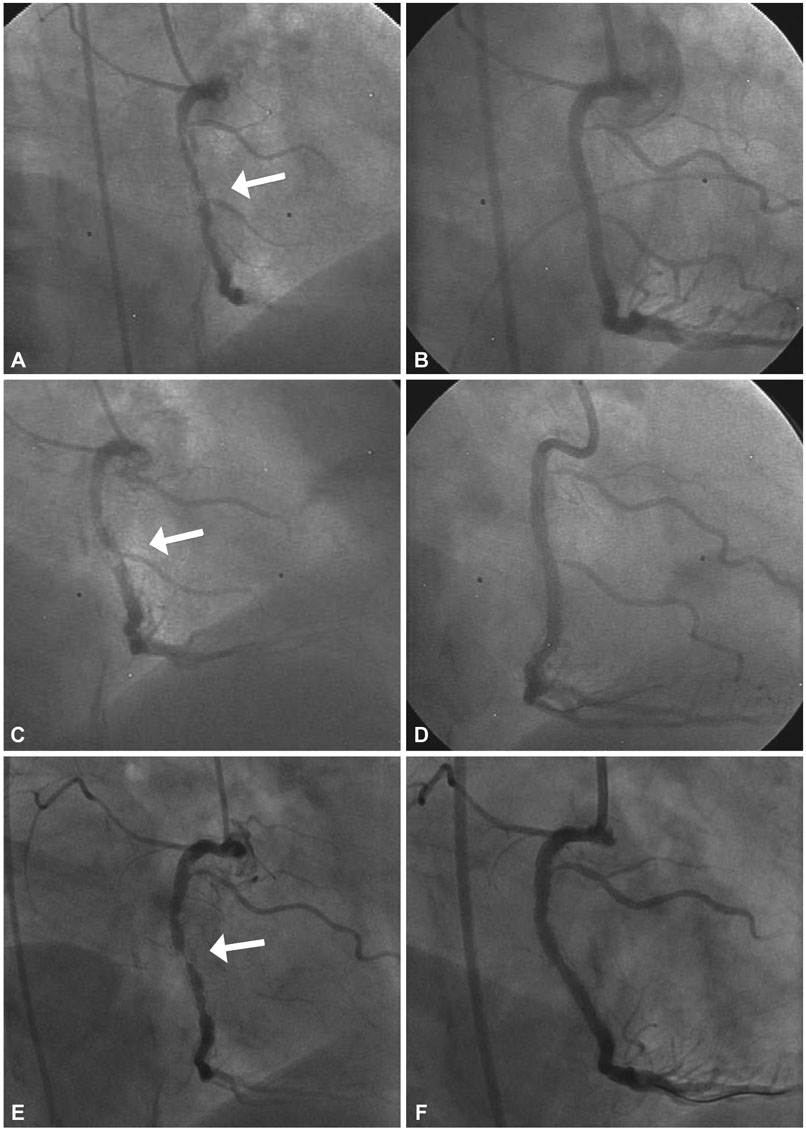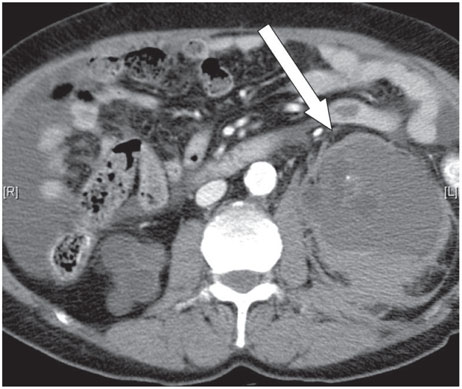Korean Circ J.
2010 Jul;40(7):348-351. 10.4070/kcj.2010.40.7.348.
Fatal Renal Bleeding in a Patient Treated With Aggressive Antithrombotic Therapy After Recurrent Coronary Stent Thrombosis
- Affiliations
-
- 1Cardiology Division, Department of Internal Medicine, Severance Cardiovascular Hospital, Seoul, Korea. shl1106@yuhs.ac
- 2Department of Urology, Yonsei University College of Medicine, Seoul, Korea.
- KMID: 2225180
- DOI: http://doi.org/10.4070/kcj.2010.40.7.348
Abstract
- Triple antiplatelet therapy has been known to be superior to the conventional dual regimen for preventing stent thrombosis after coronary stenting, and the addition of oral anticoagulation to antiplatelet therapy is also considered an option. However, the risks and benefits of a triple antiplatelet regimen plus additional oral anticoagulation must be taken into account. Here, we report a case of fatal renal bleeding in a patient treated with triple antiplatelet plus oral anticoagulant therapy for the prevention of recurrent stent thrombosis.
MeSH Terms
Figure
Reference
-
1. Honda Y, Fitzgerald PJ. Stent thrombosis: an issue revisited in a changing world. Circulation. 2003. 108:2–5.2. Gurbel PA, DiChiara J, Tantry US. Antiplatelet therapy after implantation of drug-eluting stents: duration, resistance, alternatives, and management of surgical patients. Am J Cardiol. 2007. 100:18M–25M.3. Jaffe R, Strauss BH. Late and very late thrombosis of drug-eluting stents: evolving concepts and perspectives. J Am Coll Cardiol. 2007. 50:119–127.4. Manzano-Fernandez S, Marin F, Pastor-Perez FJ, et al. Impact of chronic kidney disease on major bleeding complications and mortality in patients with indication for oral anticoagulation undergoing coronary stenting. Chest. 2009. 135:983–990.5. Manzano-Fernandez S, Pastor FJ, Marin F, et al. Increased major bleeding complications related to triple antithrombotic therapy usage in patients with atrial fibrillation undergoing percutaneous coronary artery stenting. Chest. 2008. 134:559–567.6. Jeong YH, Lee SW, Choi BR, et al. Randomized comparison of adjunctive cilostazol versus high maintenance dose clopidogrel in patients with high post-treatment platelet reactivity: results of the ACCEL-RESISTANCE (Adjunctive Cilostazol Versus High Maintenance Dose Clopidogrel in Patients With Clopidogrel Resistance) randomized study. J Am Coll Cardiol. 2009. 53:1101–1109.7. Han Y, Li Y, Wang S, et al. Cilostazol in addition to aspirin and clopidogrel improves long-term outcomes after percutaneous coronary intervention in patients with acute coronary syndromes: a randomized, controlled study. Am Heart J. 2009. 157:733–739.8. Lee SW, Park SW, Kim YH, et al. Drug-eluting stenting followed by cilostazol treatment reduces late restenosis in patients with diabetes mellitus the DECLARE-DIABETES Trial (A Randomized Comparison of Triple Antiplatelet Therapy with Dual Antiplatelet Therapy After Drug-Eluting Stent Implantation in Diabetic Patients). J Am Coll Cardiol. 2008. 51:1181–1187.9. Lee SW, Park SW, Kim YH, et al. Comparison of triple versus dual antiplatelet therapy after drug-eluting stent implantation (from the DECLARE-Long trial). Am J Cardiol. 2007. 100:1103–1108.10. Jeon DS, Yoo KD, Park CS, et al. The effect of cilostazol on stent thrombosis after drug-eluting stent implantation. Korean Circ J. 2010. 40:10–15.11. Yang TH, Kim DI, Kim JY, et al. Comparison of triple anti-platelet therapy (aspirin, clopidogrel, and cilostazol) and double anti-platelet therapy (aspirin and clopidogrel) on platelet aggregation in type 2 diabetic patients undergoing drug-eluting stent implantation. Korean Circ J. 2009. 39:462–466.12. Francescone S, Halperin JL. "Triple therapy" or triple threat?: balancing the risks of antithrombotic therapy for patients with atrial fibrillation and coronary stents. J Am Coll Cardiol. 2008. 51:826–827.13. Rossini R, Musumeci G, Lettieri C, et al. Long-term outcomes in patients undergoing coronary stenting on dual oral antiplatelet treatment requiring oral anticoagulant therapy. Am J Cardiol. 2008. 102:1618–1623.14. Ruiz-Nodar JM, Marin F, Hurtado JA, et al. Anticoagulant and antiplatelet therapy use in 426 patients with atrial fibrillation undergoing percutaneous coronary intervention and stent implantation implications for bleeding risk and prognosis. J Am Coll Cardiol. 2008. 51:818–825.15. Lip GY, Karpha M. Anticoagulant and antiplatelet therapy use in patients with atrial fibrillation undergoing percutaneous coronary intervention: the need for consensus and a management guideline. Chest. 2006. 130:1823–1827.16. Grantham JJ. Clinical practice: autosomal dominant polycystic kidney disease. N Engl J Med. 2008. 359:1477–1485.
- Full Text Links
- Actions
-
Cited
- CITED
-
- Close
- Share
- Similar articles
-
- Coronary Stent Infection Presented as Recurrent Stent Thrombosis
- Simultaneous Multivessel Acute Stent Thrombosis in a Patient with Gastrointestinal Bleeding
- Cordis Coronary Stenting without Anticoagulation: Multicenter Results in Korea
- Recurrent Stent Thrombosis and Pulmonary Thromboembolism Associated with Hyperhomocysteinemia
- Recurrent Stent Thrombosis in Different Coronary Arteries



